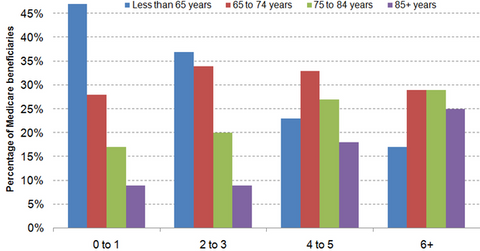Social Factors That Impact the Biotechnology Industry
The aging Baby Boomer population in the United States is one of the social factors driving the US healthcare industry. By 2030, Americans over 55 will be 31% of the population.
Jul. 6 2015, Updated 11:06 a.m. ET

Demographics
The aging Baby Boomer population in the United States is one of the social factors driving the US healthcare industry. By 2030, the number of Americans above the age of 55 is expected to reach about 100 million, which is 31% of the total projected population.
The biotechnology industry (IBB) is expected to earn profits as it continues to innovate treatments for several rare and chronic conditions that afflict older people.
The above graph shows that in 2010, the percentage of people with more than four chronic conditions increased progressively as people aged. This highlights the trend that older people make up the major portion of users of biotechnology drugs for the management of chronic ailments.
Lifestyle
The Centers for Disease Control and Prevention (or CDC) has listed heart disease, stroke, cancer, obesity, and arthritis as the most common diseases in the United States. In 2012, about 117 million people, or half of the total adult population, had one or more chronic conditions.
Unhealthy lifestyles such as lack of exercise, unbalanced diet, and smoking and alcohol abuse have been identified as major reasons leading to heart diseases, arthritis, and certain types of cancer such as lung and liver cancer. These factors have led to growth in the demand for biotechnology drugs, which is expected to translate into higher profits for biotechnology manufacturers.
Responding to this demand, biotechnology companies such as Amgen (AMGN), Biogen (BIIB), Celgene (CELG), and Gilead Sciences (GILD) have introduced several drugs that target various diseases such as cancer and arthritis. They continue to develop more advanced solutions for these conditions.
Geography
In some geographies, there’s a prevalence of certain diseases. This is a key determinant of the success of a biotechnology drug. Based on the average number of people inflicted with a disease in a given geography, health insurers that operate in that location decide whether a biotechnology drug has to be included in its list of covered drugs.
The number of afflicted people coupled with the presence of effective substitute treatments also determine the pricing of the biotechnology drug.
